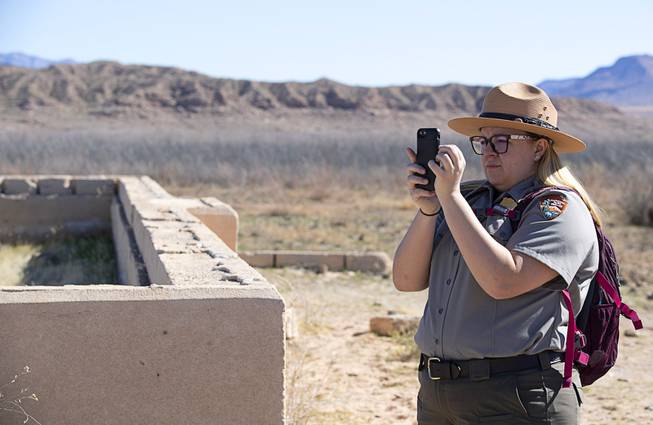
Chelsea Kennedy, public affairs specialist for the U.S. Park Service, takes a photo of the remnants of a school at the St. Thomas ghost town in the Lake Mead National Recreation Area near Overton, Thursday, Feb. 13, 2020.
Friday, Feb. 28, 2020 | 2 a.m.
Many Nevada ghost towns were rapidly established by miners and prospectors and abandoned as soon as the mines dried up. But St. Thomas, founded in 1865 as a Mormon farming outpost, was ultimately abandoned for a less typical reason: It was about to drown.
The development of the Hoover Dam and subsequent formation of Lake Mead submerged St. Thomas in 1938, forcing the town’s residents to flee. The remains of the former town, located in Lake Mead National Recreation Area near Moapa Valley, stayed underwater until 2003, when extreme drought caused the lake to recede enough to re-expose the area.
Virtual Museum
Since then, the ghost town has become a tourist attraction and an occasional reunion site for the descendants of former residents, most of whom relocated to Overton and Logandale in Moapa Valley.
“There are quite a few of them still around,” says Robin Maughan, executive director of the Old Logandale School Historical and Cultural Society in the town of Moapa Valley.
In 2019, National Park Service staff installed interpretive signs along the 2.5-mile St. Thomas trail to give visitors more information about St. Thomas’ history. The trail follows the former streets of St. Thomas and features the remains of building foundations, water-damaged but prominent.
Working with local historians, former residents and their descendants, the National Park Service has identified the owners and uses of the buildings still visible in the ghost town. Visitors can now view the remains and images of the original buildings side by side thanks to the interpretative signs.
“A lot of what we know about this area is from spoken word,” says Chelsea Kennedy, public affairs officer for Lake Mead National Recreation Area.
Although St. Thomas was established by Mormons who thought they were still in Utah, those inhabitants left the settlement six years later after the state borders were adjusted. Other settlers moved into the area during the years that followed.
In its heyday during the late 1800s to early 20th century, St. Thomas had a school, a general store, a post office, a blacksmith shop and a hotel. Its peak population was 500, and industries included salt mining and agriculture. The town was also a stopping point on the first automobile route between Salt Lake City and LA, known as the Arrowhead Trail, Kennedy says.
In 1928, President Calvin Coolidge authorized the construction of what would become the Hoover Dam. Promised compensation by the federal government, residents began to move out, often dismantling their homes to reuse the valuable building materials. By 1935, the water started rising, and the town was virtually abandoned.
“They were given a certain dollar amount for their homes,” Maughan says. “It basically was, ‘Take it or leave it,’ because their homes were going to be covered up.”
The last resident of the town was Hugh Lord, who famously stayed until 1938, when the water came lapping at his door. He escaped by boat after burning his home to the ground, according to Maughan. “He did not want it taken by the lake,” she says.
Over the years, the town sometimes became visible again during unusually dry seasons, Maughan says. On those rare occasions, former residents would meet at the site of the town and hold a reunion and ceremony, she says. The most recent one took place in 2012.
But unprecedented drought conditions in the early 2000s that continue to this day have brought the site well above the lake level, perhaps permanently. It would take at least 20 years of above-average precipitation for lake levels to exceed the elevation of the town again, Kennedy says.
“One day, hopefully it will be [submerged] and the lake will be back to higher levels, but not anytime soon,” she said.
Today, Maughan knows of one former St. Thomas resident who’s still alive and living in Hurricane, Utah. Others with ties to the former town frequently stop by the historical society with questions about its history, she says.
“People will bring me their family histories and leave me a copy,” Maughan says. “It’s like they want me to know their ancestors.”
While she has no direct connection to St. Thomas, Maughan has become fascinated by its history, especially from living in Moapa Valley, where many former St. Thomas families reside. Through the local historical society, she hopes to ensure that the town isn’t lost.
“I feel like we don’t have a presence here in Logandale and Overton without St. Thomas,” Maughan says. “We started in St. Thomas, and I don’t want that connection forgotten.”
This story appeared in Las Vegas Weekly.

